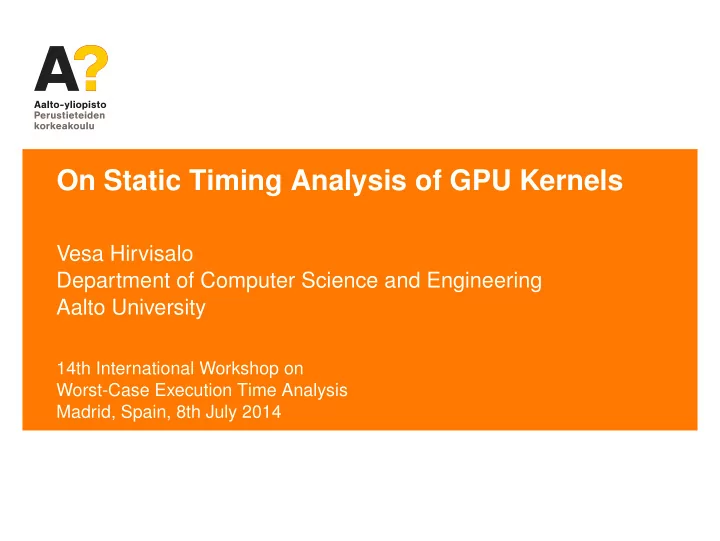

On Static Timing Analysis of GPU Kernels Vesa Hirvisalo Department of Computer Science and Engineering Aalto University 14th International Workshop on Worst-Case Execution Time Analysis Madrid, Spain, 8th July 2014 2014-07-08
Talk outline Introduction to SIMT executed kernels ◮ Co-operating Thread Arrays (CTA) ◮ warp scheduling ◮ thread divergence Static WCET estimation ◮ divergence analysis ◮ abstract warp creation ◮ abstract CTA simulation An example ◮ based on a simple machine model WCET2014 2014-07-08 2/16
Introduction Data parallel programming and accelerators ◮ we try to maximize occupancy of the hardware GPGPU computing as an example ◮ heterogeneous computing ◮ we concentrate on the accelerator (GPU) side timing ◮ hardware scheduling essential Launches ◮ Co-operating Thread Arrays (CTA) ◮ the computation is prepared on the host (CPU) side ◮ input data and a number of threads ◮ these are launched to the accelerator (GPU) WCET2014 2014-07-08 3/16
Example (1/2): a kernel Consider the following code in a language resembling OpenCL (note the use of the thread identifier Tid ): __kernel TriangleSum(float* m, float* v, int c) { int d = 0; /* each thread has its own variables */ float s = 0; /* s is the sum to be collected */ int L = (Tid + 1) * c; for (int i = Tid; i < L; i += c) { if ((d % (Tid + 1) == 0) s += 1; if (d % 2) s += m[i]; __syncthreads(); /* assuming compiler support */ d += 1; } v[d-1] = s; } WCET2014 2014-07-08 4/16
SIMT execution Threads are processed by computing units (CU) ◮ the following we assume: a single CU ◮ able to handle a single work group (set of threads) The threads are executed in warps ◮ warp width equals to the number of cores ◮ The warp has a PC, which applies to all its unmasked threads ◮ SIMT = Single Instruction Multiple Threads ◮ there are typically several warps ◮ the warp scheduler makes the choice ◮ round-robin is typical ◮ the warp must be ready ◮ if none – the execution stalls WCET2014 2014-07-08 5/16
Small analysis windows mean few paths warps warps Faster progress an analysis window The shift gives us stall Progress time−wise Progress code−wise WCET2014 2014-07-08 6/16
Divergence in execution Program flow Active threads A B C D A = 11111111 B = 11000011 C = 00111100 D = 11111111 Time Initial stack contents After branch completion R−pc Next−pc Mask R−pc Next−pc Mask − A 11111111 − D 11111111 stack top D C 00111100 Stack after divergence R−pc Next−pc Mask After reconvergence R−pc Next−pc Mask − D 11111111 D C 00111100 − D 11111111 D B 11000011 WCET2014 2014-07-08 7/16
warp1 warp2 warp3 warp4 divergent timing WCET2014 threads proceeding on matrix 2014-07-08 8/16
WCET estimation We define the total time spent in execution as T exec = T instr + T stall Considering (structured) branching we have T true _ branch if all threads converge to true T if _ else = T false _ branch if all threads converge to false T false _ branch + T true _ branch if threads diverge The warp scheduling hides the memory latencies. On the worst case we have T stall = max ( 0 , T memory − N warps ) For loops, we use the time of the longest thread in the warp. WCET2014 2014-07-08 9/16
Static divergence analysis We base our static divergence analysis on GSA. It uses three special functions: µ , γ , and η instead of the φ -function of SSA that it resembles: ◮ γ function is a join for branches. γ ( p , v 1 , v 2 ) is v 1 if the p is true (or else v 2 ). ◮ µ function is a join for loop headers. µ ( v 1 , v 2 ) is v 1 for the 1 st iteration and v 2 otherwise. ◮ η is the loop exit function η ( p , v ) . It binds a loop dependent value v to loop predicate p . We say that a definition of a variable is divergent if the value is dependent on the thread. ◮ if there are no divergent definitions for a branch predicate, we know the branch to be non-divergent. WCET2014 2014-07-08 10/16
Abstract warp construction An abstract warp A = ( V , E ) is directed graph. The nodes V have three node types: ◮ time nodes describe code regions with two values. T instr is the upper bound of the instruction execution time consumed. T shift is the upper bound of the variation of the instruction execution time caused by thread divergence. ◮ memory access nodes that mark places where memory access stalls may happen. ◮ barrier nodes that mark places where barrier synchronization must happen. An abstract warp is constructed from the code in a recursive bottom-up way WCET2014 2014-07-08 11/16
Example (2/2): CTA simulation Assuming a simple machine model (1 instr/cycle), we get the following abstract warp T = 7 T = 2 T = 7 T = 3 T = 4 instr instr instr instr instr T = 0 T = 0 T = 1 T = 0 T = 0 shift shift shift shift shift T = 4 instr T = 0 shift The abstract CTA simulation ◮ begins from the leftmost node ◮ assuming warp width = 4, we have 4 warps A final estimate T WCET = 804 ◮ a cycle accurate simulator gives 688 cycles WCET2014 2014-07-08 12/16
Conclusions Static WCET estimation ◮ divergence analysis ◮ abstract warp creation ◮ abstract CTA simulation We allow some divergence ◮ understanding divergence is essential ◮ uniform (non-divergent) execution is simpler We demonstrated an approach ◮ we used a simple machine model ◮ modeling real hardware is complex ◮ however, GPUs are rather predictable ◮ they are designed for real-time (i.e., graphics) WCET2014 2014-07-08 13/16
Recommend
More recommend